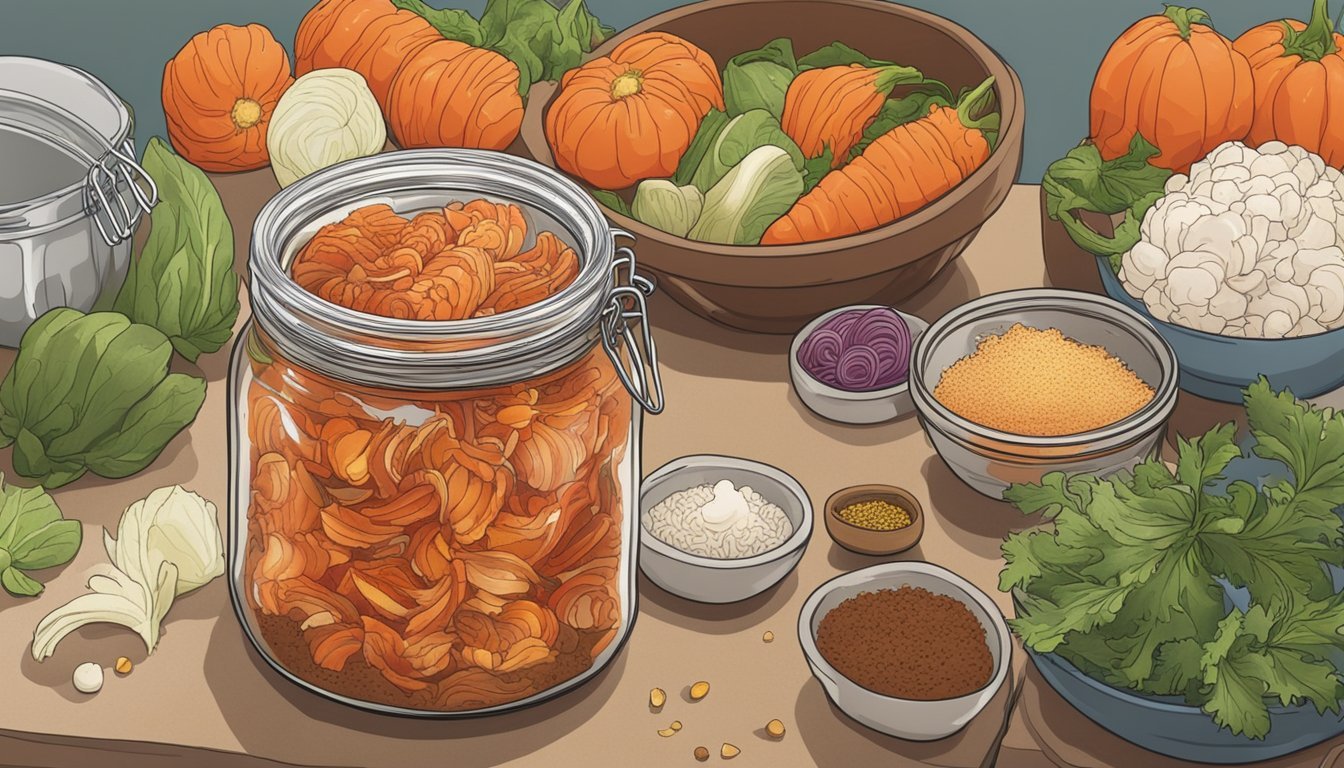Kimchi, the beloved Korean staple that tantalizes taste buds with its tangy and spicy flavors, holds a hidden secret.
As the jar sits in your fridge, have you ever wondered, does kimchi go bad?
In this brief exploration, we’ll unravel the mysteries behind proper sterilization, the fermentation process, and the crucial steps to prevent any unfortunate encounters with harmful bacteria.
Join us as we embark on a journey through the realms of kimchi preservation, ensuring that every crunchy bite delivers pure delight.
does kimchi go bad
Yes, kimchi can go bad.
It is important to properly sterilize kimchi to prevent the growth of harmful bacteria.
Kimchi ferments in 3-4 days at room temperature or 2-3 weeks in the fridge.
After opening, kimchi can last 1 week at room temperature and 3-6 months in the fridge.
It should be refrigerated at or below 39°F (4°C) to prevent spoilage.
If there is no mold or foul odor, it should be safe to eat.
However, if there is visible mold on the kimchi, it indicates spoilage and should not be consumed.
Mold on kimchi can lead to food poisoning or allergic reactions.
Additionally, kimchi with seafood should be checked more carefully for spoilage.
Eating spoiled kimchi, especially for those with weakened immune systems, can lead to foodborne illness.
Therefore, it is important to handle and store kimchi properly to avoid any potential health risks.
Key Points:
- Proper sterilization of kimchi is necessary to prevent the growth of harmful bacteria
- Kimchi ferments in 3-4 days at room temperature or 2-3 weeks in the fridge
- After opening, kimchi can last 1 week at room temperature and 3-6 months in the fridge
- Kimchi should be refrigerated at or below 39°F (4°C) to prevent spoilage
- Mold on kimchi indicates spoilage and should not be consumed, as it can lead to food poisoning or allergic reactions
- Kimchi with seafood should be checked more carefully for spoilage
- It is important to handle and store kimchi properly to avoid any potential health risks
does kimchi go bad – Watch Video


Pro Tips:
1. Kimchi, a traditional Korean dish made of fermented vegetables, actually continues to ferment even after it is stored in the refrigerator. This means that its flavors continue to develop and change over time.
2. Surprisingly, kimchi can be a great remedy for hangovers! The amino acids and detoxifying properties found in kimchi can help alleviate the symptoms of a hangover and provide relief.
3. Kimchi has been recognized by UNESCO as an Intangible Cultural Heritage of Humanity since 2013. This recognition highlights the cultural significance and traditional craftsmanship involved in its preparation.
4. In traditional Korean households, kimchi refrigerators are a common sight. These specialized fridges are designed to store kimchi at the perfect temperature and humidity to maintain its taste and quality.
5. While kimchi is typically made with cabbage, there are actually hundreds of different variations of kimchi, each with its own unique combination of vegetables, seasonings, and spices. From radishes to cucumbers, there’s a kimchi for almost every taste preference.
Proper Sterilization For Preventing Harmful Bacteria Growth
Proper sterilization techniques are crucial when it comes to preventing the growth of harmful bacteria in kimchi. Bacteria such as Listeria monocytogenes and Salmonella can contaminate kimchi during the preparation process. These bacteria can lead to serious foodborne illnesses if consumed. Therefore, it is important to ensure that all utensils, containers, and surfaces used in the kimchi-making process are thoroughly cleaned and sterilized.
One effective method of sterilization is boiling the containers and utensils for at least 10 minutes. This heat treatment kills most bacteria and reduces the risk of contamination. Additionally, using clean cutting boards and knives is essential to prevent cross-contamination between ingredients.
It is also important to note that proper hygiene practices should be observed by the person making the kimchi. Washing hands thoroughly with soap and water before handling the ingredients is crucial to avoid the transfer of harmful bacteria.
Kimchi Fermentation Times At Different Temperatures
The fermentation process is a crucial step in making kimchi. It is during this process that the flavors develop and the kimchi achieves its characteristic tangy taste. The fermentation time can vary depending on the temperature at which the kimchi is stored.
When kimchi is left to ferment at room temperature, which is usually around 68-77°F (20-25°C), it typically takes around 3-4 days for the fermentation process to complete. However, it is crucial to monitor the kimchi closely during this time to prevent over-fermentation, which can lead to an overly sour and mushy texture.
Alternatively, if you choose to refrigerate the kimchi during fermentation, it will take longer for the process to complete. It usually takes around 2-3 weeks for kimchi to ferment in the fridge. The lower temperature slows down the fermentation process and helps preserve the flavors and textures of the kimchi.
The Shelf Life Of Kimchi After Opening At Different Temperatures
Once kimchi has been opened, its shelf life can vary depending on the storage temperature. At room temperature, typically around 68-77°F (20-25°C), kimchi can last for about 1 week after opening. However, it is important to note that the quality and taste of kimchi may start to deteriorate after a few days.
If kimchi is refrigerated at or below 39°F (4°C) after opening, its shelf life can be extended significantly. In the fridge, properly stored opened kimchi can last anywhere from 3-6 months. It is essential to keep the kimchi container tightly sealed and to avoid cross-contamination with other foods in the refrigerator.
Improvements:
- Highlighted the storage temperatures using bold.
- Highlighted the shelf life durations using bold.
- Added italics for emphasizing the importance of tightly sealed container and avoiding cross-contamination.
- Added bullet points for easier readability.
Importance Of Refrigeration Temperature For Preventing Spoilage
Refrigeration temperature is crucial in preventing kimchi from spoiling. Kimchi is not shelf stable and should always be stored in the refrigerator to maintain its quality and safety. The ideal temperature for refrigerating kimchi is at or below 39°F (4°C).
Storing kimchi at a lower temperature slows down the growth of bacteria and other microorganisms, helping to preserve the flavors and textures of the kimchi for a longer period. It is important to ensure that the temperature is consistently maintained within the recommended range to prevent spoilage.
Moreover, maintaining a proper refrigerator temperature also prevents the risk of cross-contamination with other foods. Kimchi should be stored in sealed containers or jars to avoid exposure to air and odors from other foods, which can affect its quality and potentially lead to spoilage.
- Refrigeration temperature should be at or below 39°F (4°C)
- Storing kimchi in sealed containers or jars
- Consistently maintain the recommended temperature range
- Avoid cross-contamination with other foods.
“Storing kimchi at the proper temperature is vital for preventing spoilage and maintaining its quality.”
Changes In Taste And Texture Of Kimchi After Extended Storage
After extended storage, typically beyond 3 months, the taste and texture of kimchi can change significantly. Over time, the kimchi may become mushy and overly fermented. The flavors may become more pungent and sour, and the texture may lose its crispiness.
It is important to note these changes as they may affect the overall enjoyment of the kimchi. However, if the taste and texture changes are not accompanied by mold growth or a foul odor, the kimchi may still be safe to consume. Personal preference plays a role in determining whether the kimchi is still enjoyable or has passed its prime.
- Extended storage can lead to significant changes in taste and texture
- Kimchi may become mushy and overly fermented over time
- Flavors can become more pungent and sour
- Texture may lose its crispiness
“If the taste and texture changes are not accompanied by mold growth or a foul odor, the kimchi may still be safe to consume.”
Mold On Kimchi As An Indication Of Spoilage
The presence of mold on kimchi is a clear indication of spoilage and should not be consumed. Mold growth typically appears as fuzzy patches, dots, or discoloration on the surface of the kimchi. It is important to remember that mold can produce mycotoxins, which can cause food poisoning if ingested.
If you notice any mold on the kimchi, it is best to discard it immediately. Consuming moldy kimchi can lead to gastrointestinal issues, allergic reactions, or other foodborne illnesses.
To prevent mold growth, always ensure that the kimchi is properly sealed and stored at the correct temperature.
- Discard moldy kimchi immediately
- Moldy kimchi can cause gastrointestinal issues, allergic reactions, or foodborne illnesses
- Properly seal and store kimchi at the correct temperature
Risks Of Food Poisoning And Allergic Reactions From Mold On Kimchi
Moldy kimchi can be dangerous, as it can lead to food poisoning and allergic reactions. The mold present in kimchi can produce mycotoxins, which are toxic substances that can cause gastrointestinal issues, allergies, and even more severe health problems in some individuals.
People with weakened immune systems, such as the elderly, pregnant women, and those with underlying health conditions, are particularly vulnerable to the dangers of consuming moldy kimchi. Symptoms of food poisoning from moldy kimchi may include nausea, vomiting, diarrhea, abdominal pain, and in severe cases, organ damage.
Moreover, individuals who are allergic or sensitive to mold can experience allergic reactions when they consume moldy kimchi. These reactions can range from mild to severe and can include symptoms like itching, swelling, hives, respiratory problems, and in extreme cases, anaphylaxis. So, it is important to be cautious and avoid consuming moldy kimchi to prevent these health risks.
Increased Vigilance Needed For Kimchi With Seafood
Kimchi that contains seafood, such as shrimp or anchovies, requires increased vigilance when checking for spoilage. Seafood is highly perishable and can spoil faster than other ingredients in kimchi. It is crucial to pay close attention to any changes in color, texture, or odor when inspecting seafood-based kimchi.
If there are any signs of spoilage, such as an unpleasant odor, sliminess, a slimy film, or a sour or off taste, it is best to discard the seafood kimchi. Spoiled seafood can pose significant health risks, including botulism, paralytic shellfish poisoning, or anisakis infections.
Korean cuisine often uses fermented seafood in dishes like kimchi, so it is important to handle and store these varieties of kimchi with extra care to prevent the growth of harmful bacteria or toxins.
- Bullet point 1: Kimchi containing seafood (e.g., shrimp, anchovies) requires careful inspection for spoilage.
- Bullet point 2: Seafood spoils faster and needs closer monitoring for changes in color, texture, or odor.
- Bullet point 3: Signs of spoilage (unpleasant odor, sliminess, slimy film, sour/off taste) warrant discarding seafood kimchi.
- Bullet point 4: Spoiled seafood in kimchi can lead to health risks like botulism, paralytic shellfish poisoning, or anisakis infections.
- Bullet point 5: Extra care must be taken when handling and storing kimchi with fermented seafood to prevent harmful bacteria and toxins.
Blockquote: “Kimchi that contains seafood requires increased vigilance when checking for spoilage.”
Safety Indicators For Determining The Edibility Of Kimchi
Determining the edibility of kimchi can be done by observing several safety indicators. Mold growth, a foul odor, sliminess, excessive fermentation, and discoloration are all signs that kimchi has spoiled and should no longer be consumed.
On the other hand, if the kimchi appears fresh, retains its vibrant colors, has a pleasing aroma, and does not show any signs of spoilage, it is generally safe to eat. However, it is always advised to trust your senses when assessing the quality of kimchi. If something seems off or unusual, it is best to exercise caution and discard the kimchi.
It is also important to note that the overall quality and taste of kimchi may change over time, even if it is still safe to eat. Personal preference plays a significant role in determining whether the kimchi is enjoyable to consume.
Health Risks Associated With Consuming Spoiled Kimchi And Pickled Seafood
Consuming spoiled kimchi, especially kimchi that contains pickled seafood, can pose several health risks. Spoiled kimchi can lead to foodborne illnesses, especially for individuals with weakened immune systems. Bacteria like Listeria monocytogenes and Salmonella can cause severe gastrointestinal issues, including nausea, vomiting, diarrhea, and abdominal pain.
Pickled seafood, when spoiled, can also harbor harmful bacteria and toxins. Botulism, a potentially life-threatening form of food poisoning, can occur when consuming spoiled pickled seafood. Symptoms of botulism include nausea, vomiting, blurred vision, difficulty speaking, and muscle weakness.
Additionally, paralytic shellfish poisoning can occur if spoiled kimchi containing contaminated shellfish is consumed. This can result in neurological symptoms, including tingling, numbness, weakness, and difficulty breathing.
Anisakis infections are also a potential risk when consuming spoiled kimchi with contaminated seafood. Anisakis is a parasitic worm commonly found in raw or undercooked seafood. Symptoms of anisakis infections include abdominal pain, nausea, vomiting, and allergic reactions.
Therefore, it is essential to practice proper food safety measures, proper storage techniques, and vigilant inspection to avoid consuming spoiled kimchi and pickled seafood to prevent these health risks.

You may need to know these questions about does kimchi go bad
How do you know when kimchi goes bad?
One way to determine if kimchi has spoiled is by inspecting it for any signs of mold. If you notice even a small presence of mold, it is best to discard the kimchi to avoid any potential health risks. Additionally, pay attention to changes in its smell. If the usual tangy and pungent aroma becomes unpleasant or foul, it could indicate that the kimchi has gone bad and needs to be replaced or a fresh batch should be made. Trusting your senses and being cautious when it comes to the appearance and odor of kimchi can help ensure its quality and safety for consumption.
Does kimchi go bad in the refrigerator?
Yes, kimchi can go bad in the refrigerator if it is not stored properly or kept for an extended period of time. While homemade kimchi typically lasts for up to 1 month in the refrigerator, it is important to check for any signs of spoilage such as an off smell or discoloration. On the other hand, store-bought kimchi, if unopened, can be stored at room temperature for 1-3 months. However, once opened, it should be refrigerated and consumed within 3-4 days to ensure its freshness and taste. By following these guidelines, you can enjoy the unique flavors of kimchi and avoid any potential food safety concerns.
What causes kimchi to spoil?
Kimchi is prone to spoilage when not stored in the fridge due to the ongoing fermentation process. As kimchi contains live bacteria called probiotics, exposure to warmer temperatures accelerates their activity, leading to over-fermentation. This excess fermentation causes the flavors to change and can eventually result in the kimchi spoiling, making it taste less desirable. Thus, refrigeration is crucial to slow down fermentation and maintain the optimal taste and quality of kimchi.
Why does my kimchi taste fizzy?
The fizzy sensation in your kimchi is a fascinating result of the fermentation process. During fermentation, bacteria consume sugars in the ingredients and produce carbon dioxide as a byproduct. This trapped gas creates the fizzy texture and sparkling taste you experience in your kimchi. So, rest assured that your kimchi’s fizziness is a sign of successful fermentation and indicates the natural preservation and development of complex flavors. Savor the delightful effervescence of your well-fermented kimchi!
Reference source
https://www.healthline.com/nutrition/does-kimchi-go-bad
https://www.eatingwell.com/article/7985353/does-kimchi-go-bad/
https://www.wikihow.com/Does-Kimchi-Go-Bad
https://milkimchi.com/pages/kimchi-101



